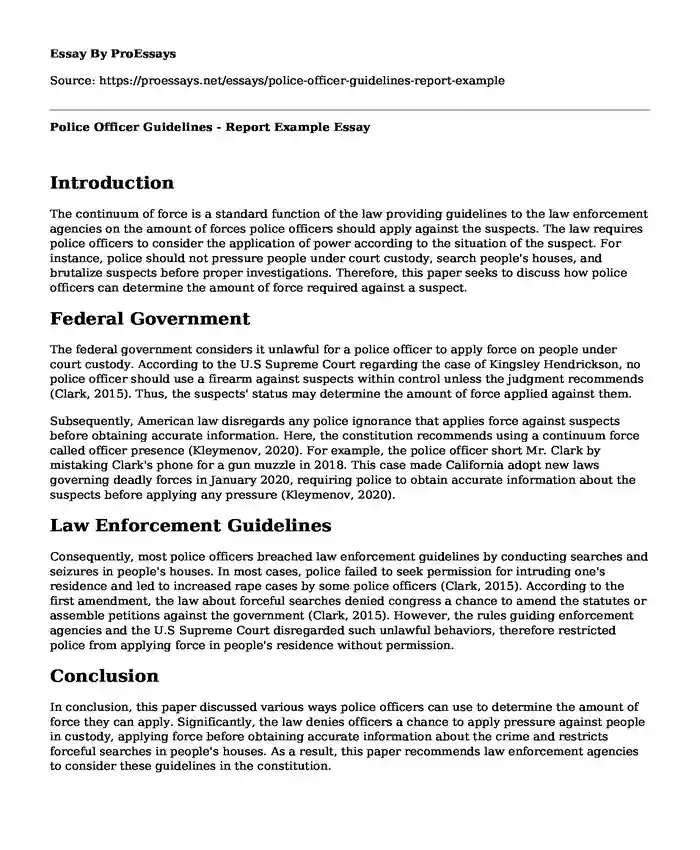Introduction
The continuum of force is a standard function of the law providing guidelines to the law enforcement agencies on the amount of forces police officers should apply against the suspects. The law requires police officers to consider the application of power according to the situation of the suspect. For instance, police should not pressure people under court custody, search people's houses, and brutalize suspects before proper investigations. Therefore, this paper seeks to discuss how police officers can determine the amount of force required against a suspect.
Federal Government
The federal government considers it unlawful for a police officer to apply force on people under court custody. According to the U.S Supreme Court regarding the case of Kingsley Hendrickson, no police officer should use a firearm against suspects within control unless the judgment recommends (Clark, 2015). Thus, the suspects' status may determine the amount of force applied against them.
Subsequently, American law disregards any police ignorance that applies force against suspects before obtaining accurate information. Here, the constitution recommends using a continuum force called officer presence (Kleymenov, 2020). For example, the police officer short Mr. Clark by mistaking Clark's phone for a gun muzzle in 2018. This case made California adopt new laws governing deadly forces in January 2020, requiring police to obtain accurate information about the suspects before applying any pressure (Kleymenov, 2020).
Law Enforcement Guidelines
Consequently, most police officers breached law enforcement guidelines by conducting searches and seizures in people's houses. In most cases, police failed to seek permission for intruding one's residence and led to increased rape cases by some police officers (Clark, 2015). According to the first amendment, the law about forceful searches denied congress a chance to amend the statutes or assemble petitions against the government (Clark, 2015). However, the rules guiding enforcement agencies and the U.S Supreme Court disregarded such unlawful behaviors, therefore restricted police from applying force in people's residence without permission.
Conclusion
In conclusion, this paper discussed various ways police officers can use to determine the amount of force they can apply. Significantly, the law denies officers a chance to apply pressure against people in custody, applying force before obtaining accurate information about the crime and restricts forceful searches in people's houses. As a result, this paper recommends law enforcement agencies to consider these guidelines in the constitution.
References
Clark, R. (2015). The internationalization of U.S. Criminal Law Enforcement. Criminal Law Forum, 6(1), 115. https://doi.org/10.1007/bf01095722
Kleymenov, M. (2020). Problems of criminal legal forecasting of individual criminal behavior. Law Enforcement Review, 4(2), 99.
https://doi.org/10.24147/2542-1514.2020.4(2).99-108.
Cite this page
Police Officer Guidelines - Report Example. (2023, Nov 25). Retrieved from https://proessays.net/essays/police-officer-guidelines-report-example
If you are the original author of this essay and no longer wish to have it published on the ProEssays website, please click below to request its removal:
- Essay Sample on Change Towards Gender Neutrality
- The Tokyo Housing Crisis - Paper Example
- All-Hazards Approach to Emergency Preparedness Paper Example
- Joe Doe v. Russell County School Board: Lawsuit Over Sexual Abuse - Essay Sample
- Progressivism: Social Reform to Improve Lives - Essay Sample
- Essay Example on Health Care, Social Justice, and Ms. Lauder
- Paper Example on Abolish Electoral College: Inefficient & Unjust







